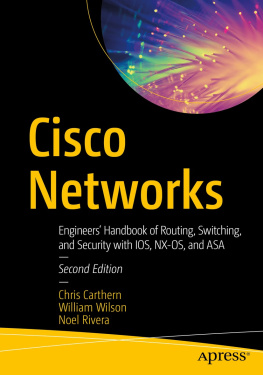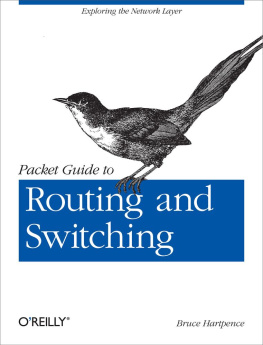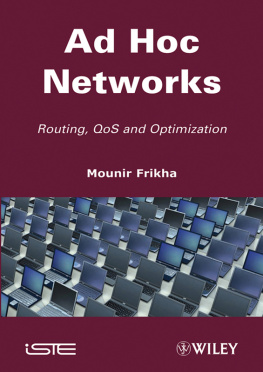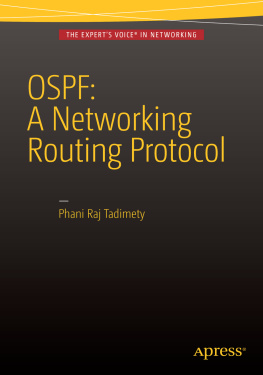Chris Carthern, William Wilson, Richard Bedwell, and Noel Rivera 2015
Chris Carthern , William Wilson , Richard Bedwell and Noel Rivera Cisco Networks 10.1007/978-1-4842-0859-5_1
1. Introduction to Practical Networking
begins by discussing a few of the tools that you will use throughout the book. Next, we cover the beloved OSI model and discuss how it relates to networking. We talk about all seven layers of the OSI model. Then we move on to the TCP/IP model and show its relation to the OSI model. We end the chapter discussing well-known port numbers, the different types of networks, and Ciscos hierarchical internetwork model.
So you want to become a good network engineer? Let us give you some advice: do not believe that you know everything there is to know about networking. No matter what certifications or years of experience you have, there will always be gaps in knowledge, and people that know or have experienced issues that you may not have. Troubleshoot issues systematically from layer to layer. Use your resourcessuch as this book! You can never have too many resources at your disposal in your toolbox. Do not be afraid to ask for help. Do not be ashamed because you cannot resolve a problem. That is why we have teams of engineers. Everyone has their expertise and we must use each to our advantage. Remember when dealing with networks it is always better to have a second pair of eyes and another brain to help resolve issues quickly. This will help you save time and stop you from working in circles. You want to know how you can become a good network engineer? Start by reading this book and complete the lab exercises to reinforce what you have learned. The rest will come from experience on the job. Practice makes perfect!
Tools of the Trade
How do you practice in a lab setting? We all cannot go around buying our own network equipment and creating our own lab environment. The best thing is to configure and test with real equipment that can be bought secondhand on eBay. There are also many tools that can be used to simulate routers in a virtual environment. Because all of the devices are virtual, they come with limitations on what you can do with them. These limitations are discussed in Appendix A.
To become proficient at anything, practice is needed, and to be efficient, tools are needed. Our tool of choice to practice and simulate network topologies is the Graphical Network Simulator (GNS3), and our tool of choice to peek into the network packets is Wireshark. There are other tools that you can use, but we found these two to be the easiest and most straightforward. Just in case you want to look at other options, a quick Internet search for network simulators and network sniffers will provide a list of the available alternatives to GNS3 and Wireshark, respectively.
GNS3 provides a simple all-in-one distribution that integrates Wireshark, VirtualBox, Qemu, and Dynamips among other tools, allowing simulation of network devices and virtualized workstations or servers. A simple visit to www.gns3.com and https://www.wireshark.org , or a search on YouTube will glean vast amounts of information on how to use the tools. You need to be able to get an IOS image; do not violate any license agreements. We will use GNS3 and Wireshark exclusively throughout this book.
Cisco Packet Tracer is a network simulation tool that allows you to simulate the configuring, operation, and troubleshooting of network devices. For more information, visit https://www.netacad.com/web/about-us/cisco-packet-tracer .
Cisco Virtual Internet Routing Lab (VIRL) is a network simulation tool that uses virtual machines running the same IOS as Ciscos routers and switches. It allows you to configure and test real-world networks using IOS, IOS XE, IOS XR, and NX-OS. For more information, visit http://virl.cisco.com .
Open Systems Interconnection (OSI) Model
Before we define the OSI model, lets talk about why it should be important to you. First, the OSI model is something you should understand and not just gloss over. We understand that the thought of the model can put people to sleep if you have not had that morning coffee yet, but it can be an immense aid if you know how protocols communicate with one another and how each layer operates with another. How is it that a PC can communicate using so many protocols, or why can many companies create technologies that interoperate with others technologies? Even though you may be a network engineer and think that you will only work at layers 2 and 3, it is important to know and understand how all the layers of OSI function. This will aid you when it comes to troubleshooting layer 1 and many of the applications you may use to monitor your devices. If you know the OSI model, you can create your own troubleshooting methodology. Gaining the theory and the hands-on practice allows you to know which layers to troubleshoot after you have tested a cable, as data gets closer to the device of the end user. Now that you know how important it is, lets talk about the OSI model.
The OSI model is a conceptual model, also known as the seven-layer model , which was established by the International Organization for Standardization (ISO) and the International Telecommunication UnionTelecommunication Standardization Sector (ITU-T) to develop commonality in function and interface between communication protocols.
It is important to note that the OSI model is not a set rule but merely a reference guide for vendors to follow so that their products can interface with one another. The seven layers can be seen in Table . The purpose of the model is to allow multivendor networks to interoperate independently and only require knowledge of interfaces between layers.
Layer Number | Name of Layer |
|---|
| Application |
| Presentation |
| Session |
| Transport |
| Network |
| Data Link |
| Physical |
The OSI model breaks up/groups functions of communication into seven logical layers: physical, data link, network, transport, session, presentation, and application. Each layer supports the layer above it, and is served by the level below it. It is important to note that processing is self-contained and transparent to the other layers. The application, presentation and session layers define how applications within end units communicate with one another and users. Traditional examples of end units on a network are PCs, servers, printers and scanners. However, with the evolution of the Web of Things, even your appliances and lightbulbs could be end units.
The physical, data link, network, and transport layers define how data is transmitted from source to destination. The lower layers are important in the processing of intermediary devices such as routers. Table shows the seven layers. The layers will be discussed in more detail later in the chapter.
The following are some of the advantages of the OSI model:
It standardizes the industry and defines what occurs at each layer of the model.
By standardizing network components, it allows many vendors to develop products that can interoperate.
It breaks the network communication processes into simpler and smaller components, allowing easier development, troubleshooting, and design.








